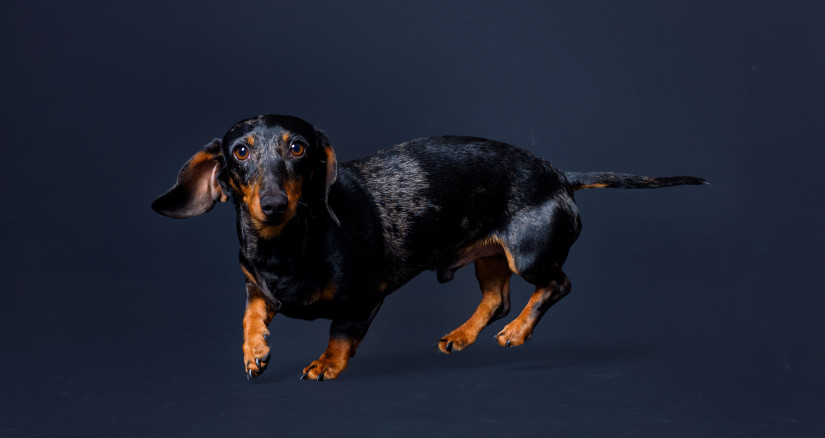
Be Careful What You Select For
Selective breeding practices in pets can sometimes have undesirable consequences. When certain desirable breed characteristics are selected for, undesirable traits may sometimes appear in offspring. Within the past year, a peer-reviewed publication retrospectively evaluated dachshunds and a certain gene associated with intervertebral disc calcification, which can lead to a higher incidence of intervertebral disc disease (IVDD).
The researchers evaluated 407 dachshunds’ genotypes (variations of genetic makeup) over a 12-year period, specifically looking for a gene labeled FGF4L2, also known as the CDDY gene, which is short for chondrodystrophy. Chondrodystrophy refers to abnormal cartilage development and is also associated with short limb length, which is commonly selected for in breeding dachshunds as they can be desirable among pet owners and in show dogs.
Intervertebral discs are designed to be cushions between vertebrae and to help protect the spinal cord and nerves. When a disc becomes calcified and loses much of its shock-absorbing properties, there is a greater risk that the disc's center will herniate and put pressure on nerves, resulting in pain and other severe symptoms. This can lead to debilitating conditions such as severe pain, incontinence, and, in severe cases, limb paralysis.

Photo by ElinaNova
Dachshunds and other breeds tend to be more prone to IVDD than most breeds because their long bodies, in combination with short legs, can put pressure on the spine and associated intervertebral discs. Dachshunds are the dog breed with the highest incidence of IVDD; up to 25% of dachshunds may show some form of IVDD over their lifetime.
In the study, authors found that when dachshunds had two copies of the CDDY gene (which is also associated with shorter limb length), they had a much higher incidence of calcified intervertebral discs, which can ultimately lead to a higher incidence of IVDD in those dogs. Statistically, these researchers found a significant difference in disc calcification scores between dogs with no CDDY genes and those with two CDDY genes.Interestingly, there was no statistical difference between dogs with one CDDY gene copy and those with two copies. Simply put, as breeding practices have selected for desirable short legs in dachshunds, they have also helped propagate more back problems in dachshunds. This study concludes that breeding dachshunds should be evaluated for the CDDY gene to help limit this painful condition.

Photo by wirestock
This is a great example of how intentional breeding practices for traits can also have unintentional but grave consequences for pets. There are other examples of genetically linked diseases in pets that can be tested for inbreeding animals. The Orthopedic Foundation for Animals (OFA) lists many genetically linked diseases in pets that can be tested for. Dobermans can carry two different genes that make them more susceptible to dilated cardiomyopathy: PDK4 (DCM1) and TTN (DCM2). Both can be tested for. Additionally, there is a test for a gene linking copper toxicosis in Bedlington terriers (COMMD1) that can also be evaluated. The DMN1 gene is associated with many breeds, including various retrievers, Boykin spaniels, and Old English sheepdogs, and is associated with exercise-induced collapse. These are just a few examples of genes linked to specific diseases in purebred dogs that breeders can test for. In addition, OFA guidelines include scoring methods to evaluate radiographs of joints, such as hips and elbows, which can be used to select genetically sound individual breeding dogs when evaluated by veterinarians and performed according to OFA guidelines.
The entire pet industry should push to ensure that each of these practices—from genetic testing to radiograph evaluations—is always used to select the best possible breeding dogs. If breed associations and consumers demand it, then these tests and screening procedures would be required. After all, aren’t we here to help lessen the incidence and severity of all diseases, especially preventable ones, in our furry friends? At BSM Partners we develop hundreds of pet health products a year and help to influence the best breeding practices for our pets. Because no matter how well a pet’s health is taken care of by feeding quality diets, treats and supplements if preventable diseases are occurring pet parents need to take a stand.
Follow us on LinkedIn for the latest updates on all things happening here at BSM Partners.
About the Author
Dr. Bradley Quest, DVM, is the Principal Veterinarian at BSM Partners. He has practiced clinical veterinary medicine, developed and tested hundreds of pet food and health products, performs extensive animal health research, and helps navigate pet food ingredient approval for clients.
This content is the property of BSM Partners. Reproduction or retransmission or repurposing of any portion of this content is expressly prohibited without the approval of BSM Partners and is governed by the terms and conditions explained here.